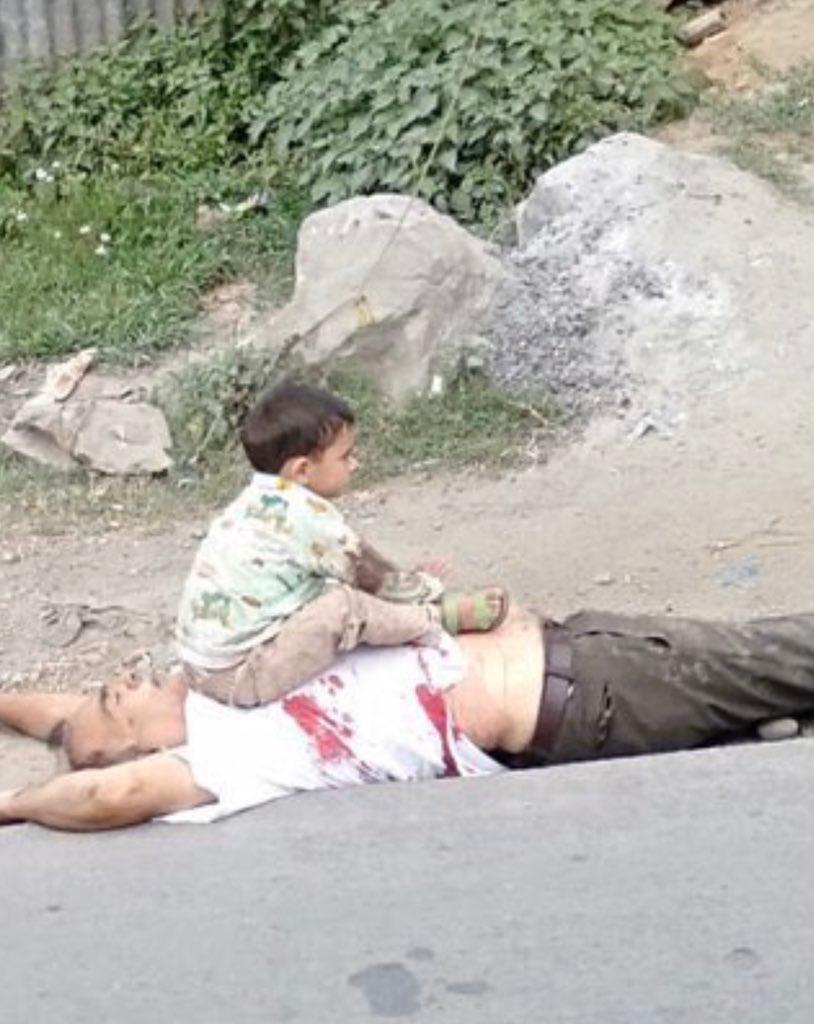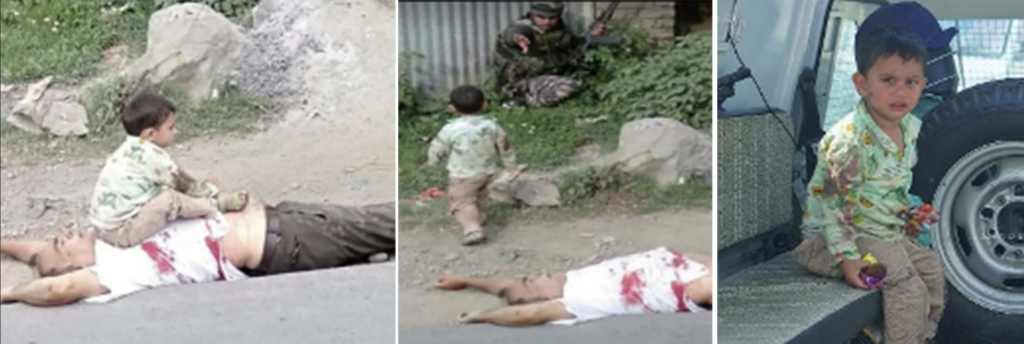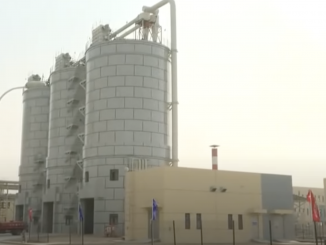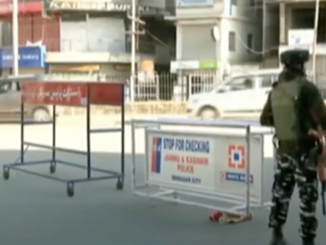
On the morning of 1 July 2020, a 65 years old person (identified as Bashir Ahmed) was shot dead in Srinagar suburbs, allegedly by the Indian Central Reserve Police Force (CRPF). Many are killed as a routine in Indian Occupied Kashmir (IOK) daily and rarely form part of the Indian media breaking news. However, this routine and “insignificant event”, instantly became viral due to the post killing images and video showing a three years old grandson accompanying his (now shot and killed) grandfather, Ahmed. Consequently, this event and the on-going Indian discourse of brutality in the IOK necessitates a critical visual reflection.
The theory of state brutality against its noncombatants accounts for multiple causes grounded in a variety of motivations including strategic, religious, and ideological reasons, is expressed in a variety of ways, and can take ingenious manifestations. The Indian discourse of brutality can appropriately be demarcated by the distribution of non-negotiable violent force employed brutally with the New Delhi-dictates of an intuitive grasp of ultra-judicial situational exigencies in IOK. Resultantly, the Kashmiris and Muslim minorities in India are overrepresented as the human targets of brutality and murder.
These images involving a child, are not the first ones to grab the attention of humanity (or whatever is left thereof, in today’s India…). Images have always been argued as the powerful means to affect change, and the presence of children in such brutal and violent images has remained the focus of attention among students of “representation”. For example, the 1972 image of a 9 years old naked Vietnamese girl named Kim Phuc, running away from the Napalm bomb attack, captured by Nick Ut, or the 1992 image of a hungry and weak Sudanese child slumped on the ground and a vulture couching behind the child, captured by Kevin Carter, and a more recent image of Syrian child Aylan Kurdi washed ashore in Turkey during 2015, captured by Nilofur Demir, instantly merited global attention. Additionally, authors have critically analyzed the images from philosophical, political, and value addition angles, besides volumes written on the tools of image analysis.
As argued by John Berger in his 1973 book Ways of Seeing, every image embodies a way of seeing. Similarly, a discourse constitutes ways of seeing the world and ways of being and living in the world. The discursive “world” for the residents of IOK finds nothing novel about the state brutality, bestowed upon them from the Indian military and police as a state-sponsored agenda. This, extremely harsh, bitter, and most violent treatment would prevent them from daring to think of themselves as human beings. So, the Indian security forces could kill, rape, plunder, and pillage the Kashmiri villages and cities. while humanity watches in a state of criminal silence.

The first of the three (focal) images show a child sitting and crying on the chest of the man who was shot and killed. In Image 2 the child is moving away and is being directed by a uniformed person to move away and in Image 3 the child has been shown sitting in a (military or police) vehicle and can be seen crying. Additionally, the video, besides being outright brutal, is gruesome for anyone with little sagacity for humanity, and a true reflection of humanity at its lowest ebb. The video shows helpless, violated, and harrassed crying child, travelling in an armoured vehicle, can be seen crying to go to his mother.
The first image reveals two contrasting realities: 1) a child sitting on the chest of a dead man (his grandfather), can be argued to have the feelings of loss of a dear one, whose chest was once his amusement abode; 2) to the contrary, it can also be argued that the photographer (CRPF in this case), made the child sit on the chest of his dead grandfather to exhibit state power as a warning against anyone who is suspected of deviation. A clear message that the state holds the unchallenged power with absolutely no regard for the dying humanity; 3) the (psychologically and common-sensically unusual) position of the child facing away from his grandfather’s face is a clear indicator of an iconoclastic indulgence, depicted by carefully placing the child on the chest by the photographer.
In Image 2, a soldier in the background has been photographed instructing the child away from the previously used frame. This is an effort in the protection of the state narrative, that his grandfather died in a crossfire and the CRPF cares and wants to save the child’s life. Image 3 is nothing but a repetition of Omran Daqneesh, who was photographed sitting in an ambulance in Allepo, to depict the Assad regime’s brutalities in Syria against its citizens. Omran’s image was later on claimed to be false and purposefully photographed by the Western media outlet. In Image 3, the toys held in child’s hand, and the “chocolate” being offered to him as an answer to his cries to go to his mother shown in the video, point to another face of Indian state narrative, depicting its atrocities to be “soft” in approach.
Contradictory stories surround the entire event. On one hand, the family of the killed has claimed that he was shot by the CRPF, whereas the police chief claims that Ahmed was killed in a crossfire between the police and the militants, who attacked the police from a nearby mosque. Regardless, the tragedy is epitomized in the entire ordeal. As if imagining a child in such a violated and inhumane space is not heart wrenching enough, that the Indian security forces went a step ahead and arranged for a photoshoot of the child on the chest of his dead grandfather. The sequential arrangement of these photos shows a pre-arranged, well planned, and to some extent a professionally mosaicked set of photographs of a three years old child, who seems psychologically harassed, confused, and terrified about what he just saw.
For the child, probably, the first experience of being an eye witness to the murder of a loved one, probably with no knowledge of human rights violations in the land which was once “heavenly”, and probably a memory which will last a lifetime for the child (that is, “if” this child is allowed to live long enough in the face of the ongoing state brutality), however, the state continues to slide to the lowest levels in human rights.
Arthur Schopenhauer, the 19th Century German philosopher posited that the pleasure in tragedy is the highest degree of feeling of sublime, and the tragic catastrophe makes us feel urged to turn our will away from life. In the case of this event, the tragic and catastrophic death of the loved one in front of his eyes is likely to have a lasting effect on the child, and the family (like many others in IOK) will certainly have their will turned away from life. The event and the entire photoshoot is an embarrassment, and humiliation for the silent humanity, and a disgrace for indignant India, Indian armed forces, and Modi’s government.
The reflection on these images exemplifies the divergent accounts and an uncanny contextual harmony between the state brutality and the visual representation. Scholars have argued that one of the major achievements of the images and visual representation is that they can significantly change the dominant ideologies. In this case, the immediate rebuttal from the police chief is the case in point, and the state narrative has been laid down by threatening prosecution against anyone (including Ahmed’s family) who claims a counter-narrative about this event.
The images were shot by the CRPF operatives, who, as per the touted instructions are not allowed to carry cameras or mobiles while on duty. Yet again, this is not the first time that the armed personnel in IOK have violated the human rights of the oppressed and marginalized population of Kashmir, and photographed the event. The image depicting a civilian human shield, tied in front of a military jeep went viral during 2018 and received a shameful amount of criticism. However, unfortunately, both shame and humanity remain in direly short supply in New Delhi ruling quarters.
Revealing a child’s identity is against Article 74 of the Indian Constitution. But the Modi government and the state agents operating in IOK seem to have lost all semblance of humanity and continue to violate the Indian constitution and the rights of its citizens with impunity. The state-sponsored inhumane treatment, brutality, violence, and terrorism are not only limited to Indian Muslims, or in IOK only, India has openly embarked upon destabilizing its neighbours as has been witnessed and confirmed by PM Imran Khan after the recent Karachi Stock Exchange Indian sponsored terror attack.




Wonderful piece of expression
Shameful and inhuman act of Indian Army . . . May Allah Pak bless Kashmiris with freedom.
A great piece of writing .